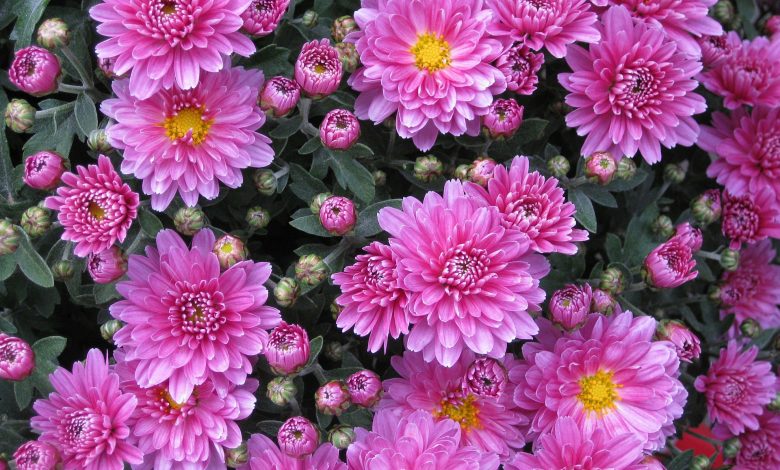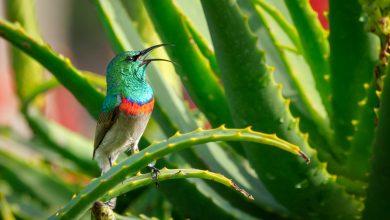Best Annual Flowers to Plant Each Year

When it comes to planting flowers each year, you may wonder what to choose. Annual flowers are those that bloom throughout the season and then die at the end of it. Usually, this occurs between spring and fall.
Whether you are lining the sidewalk, planting a window box, or just adding some annuals to your perennial garden, it’s important to know which ones are best. Of course, you also need to know how to grow annual flowers, so a helpful guide is included at the end.
If you’re looking to round out the garden or add a planter on the porch, annual flowers can provide interest and color. They do need to be replaced each year, but they are often less expensive than their perennial counterparts. With that, you may decide to change the flower arrangement each year, making annuals the best choice.
Angelonia
These beautiful flowers are resistant to drought and heat, making them ideal for gardeners living in the south of the United States. They come in a variety of colors and stand tall on a stalk-like stem. In fact, there are multiple flowers along the stalk, giving you a bunch of flowers that can stand tall and proud. They prefer full sunlight and bloom during the summer. Therefore, it is best to plant them in the spring so that they’re tall and luxurious throughout the warmer months.
Begonias
A bunch of tiny, delicate flowers can add femininity to the garden, as well as a pop of color. The dainty flower can bloom in red, pink, and white shades, so it is perfect for any garden. Plus, they don’t need a lot of upkeep and maintenance, making them suitable for the novice gardener or someone without a lot of time. You aren’t going to be standing over them pruning and deadheading all the time.
They do prefer full sunlight, but they also like partial shade. You can also grow begonias in full shade, making them perfect for the corners of the garden that don’t get a lot of sun. These flowers typically bloom in summer, so you want to plant them in the spring. Plus, you can take them in the house in the fall so that they keep flowering. When they finally die, it’s possible to dig up the tubers and reuse them the next year, making them a cost-effective choice.
Celosia
If you’re looking for a unique and interesting annual, you need some celosia in your garden. They’re highly colorful and come in many shapes. Often, they look like Troll doll hair and tend to stand up, though they aren’t very tall. Shape options can include plumes, fans, and brains. You can also find many color options, including yellow, red, pink, and orange.
These plants prefer full sunlight and bloom during the summer. Therefore, consider planting them in early or late spring to get the full effect. You’re going to be impressed by how quickly they grow and how little maintenance is involved in caring for them.
Chrysanthemum
When it comes to annual flowers, the timeless classic seems to be the chrysanthemum. It’s hard to spell and say at times, but they are truly an amazing flower to have in the garden. They have countless curled petals that all point to the center of the flower and can stand quite tall. Sometimes, they’re called mums for short, and they’re a must-have for any garden.
You can choose to grow them from seeds in the spring or buy them from the local nursery in early summer. They do prefer full sunlight and start blooming in late summer. However, they continue flowering throughout the fall months, as well.
Cosmos
Cosmos are feminine, cute, small flowers that come up in bunches. They can grow taller and taller as you cut them. Therefore, you can choose the height you like by continuing to cut the flowers or leaving them alone. They primarily come in shades of purple, pink, and white and bloom during the summer.
It is ideal to plant them in the spring in a place that gets full sunlight. They do require a bit more maintenance than others listed here, but they look amazing in the garden and can grow to about any height you desire.
Dahlia
If you’re interested in a stunning, bold bloom, the Dahlia is a must-have. It can make your garden bed look lush and full. There are plenty of varieties to the Dahlia flower, and you can find fluffy styles like peonies or honeycomb-style shapes. This means you can choose what you like best.
Of course, these flowers are quite easy to grow, though they do have specific care requirements. They like full sunlight and tend to bloom throughout the summer. Plus, in the fall, you can dig up the tubers and reuse them every year. This ensures that you save money and have something that is always going to look beautiful in your garden.
Geraniums
The geranium is a popular annual because it features small bunches of small flowers on each ‘head.’ They are ideal for planting along the porch or walkway, and they can also be used in the yard. These blooms tend to be petite and perky and can grow in pots or the ground.
If you’re looking for a fuss-free annual, this is the choice for you. They can grow in partial shade or full sunlight. Generally, geraniums bloom during the spring and summer, so you may want to plant them in a pot indoors and then transfer them to the ground when the weather warms up a bit.

Larkspur
Those who love blue and purple are going to enjoy larkspur because it features both colors throughout the petal arrangement. It’s a taller flower that showcases an almost cascading effect. There is a flower at the top, then two or three below that, and then a group of four or five. Therefore, it gets bushier and fuller as you get closer to the base.
These flowers grow best in cool climates, so you should consider planting them in the fall. Plus, the seeds can withstand freezing temperatures. That way, you can have beautiful blooms throughout the spring and early summer. They also grow in partial or full sunlight, making them ideal in a variety of locations around your home.
Marigolds
Marigolds are annual flowers that come in many varieties and colors. They feature a puff-style flower on top of a short stem. Generally, you can find orange and yellow shades, and they’re fast-growing. However, they don’t have a smell, though the orange ones can, at times, smell slightly pungent. In fact, that version can help to keep away pests, such as wasps.
Each plant offers about 15 flowers each, so you’re getting a lot for a little bit of money. They tend to bloom during the summer and require full sunlight for best results.
Pansies
Those who want a bold flower that’s frost-resistant are going to like pansies. The petals feature a cascading effect, so it gets wider from the center and looks almost like a circle. They come in a variety of colors, and you can also find multi-color options.
These flowers are ideal for your spring planting because they can tolerate late frosts. Still, they only bloom during the spring, so you want to get them planted quickly so that you can enjoy them. Plus, they can withstand partial shade, though they do prefer full sunlight.
Petunias
The petunia is another fuss-free flower that is ideal for putting in pots, containers, hanging baskets, window boxes, and garden beds. They feature a small center with a wider petal and a unique style. Plus, they come in a variety of shades, such as purple, yellow, red, and white.
These annuals can bloom in spring, summer, and fall, so you are sure to have vibrant colors in your yard for many months. They do prefer full sunlight, so it is best to consider placement carefully.
Ranunculus
Another bold flower option is Ranunculus. It looks similar to a rose in that it starts off tight in the center and then unfolds to create rounds of petals. These flowers tend to be highly fragrant, as well.
It is ideal to prepare and plant the flowers in the fall so that you can get the best blooms come springtime. You can use the tubers the next year, but you may find that the results aren’t the best. Ranunculus tends to grow the best with a fresh corm. Still, they are highly colorful and come in orange, yellow, red, pink, or white.
They’re sure to look stunning in the garden or cut and arranged in a vase. These flowers bloom primarily in spring and require full sunlight to thrive.
Snapdragon
Named as such because of the petal’s similarities to dragon scales, snapdragons are ideal for adding dimension, height, and bold color to the garden. They do grow very tall and don’t require a lot of maintenance or work. Therefore, you can expect to have them thriving and adding depth to the garden throughout the summer.
Of course, they do like full sunlight. While you can bunch them in closely with other flowers, you need to ensure that the plant gets equal amounts of sun as the others. Otherwise, they are going to be dwarfed and may not grow completely.
Sunflower
Everyone knows what a sunflower looks like, with its brown center and bright yellow petals going around in a circle. You may not know, though, that sunflowers come in other shades, such as white, pink, red, and orange. They grow quite tall (several feet), so they are likely going to need to be staked to support them enough to flourish.
Generally, sunflowers bloom throughout the summer and early fall months. Of course, as the name suggests, they prefer full sunlight. During the fall, you can collect the seeds from the middle of the plant and use them to grow new sunflowers next year. You can also roast and eat them.

Planting Tips
Now that you know which annual flowers are the best to grow in your garden or yard, it’s time to learn how to plant them.
Generally, annuals are going to race through their growing season, providing colorful foliage and unfurling leaves through spring and summer until frost sets in. Since you don’t have long to enjoy these beauties, it’s important to know when to plant them to get your season off to a solid start.
You learned earlier that some annuals prefer full sunlight, while others can live in partial or full shade. Some are going to thrive in the cooler months, while others prefer the full heat of summer. When you go to a garden center or nursery, they are likely to sell the appropriate annuals for the season coming up. However, you can always ask an employee. Sometimes, summer annuals start off growing in the greenhouse, which is warm and cozy. Therefore, they can stop growing when they are planted outside, and it is much cooler. In short, it can damage the plant if you put it into the ground too early.
Often, you should try planting your flowers on a day that is cloudy. Newly planted annuals aren’t going to get as stressed from the sun while they settle into their new home. Planting can also be done at night, giving them a full twelve or more hours to recover from being replanted. If your only free day for planting falls on a sunny one, consider erecting shade devices to protect your seedlings. Bend a piece of cardboard and tent it over the plant.
Consider Arrangements
Yes, you want to jump right in and start digging, but you need to plan your garden too. The right pattern is essential to ensure that colors blend well or stand out and pop. Plus, you need to make sure that the plants next to others can live comfortably. For example, a snapdragon is going to be tall, so it might work well paired next to a geranium, which can withstand partial shade.
It’s easy to do this; all you have to do is arrange the plants in the pots in the pattern you want to follow. Then, remove a plant from its container, plant it in the ground, cover it, and water it. Move on down the line until all of the plants have been replanted. Just make sure that you also give your plants enough room to grow and spread out.
Removing Them from the Container
While it is quite easy to plant annual flowers, there are a few things to consider. For example, you should test the pot or cell pack for dryness and water it first if the soil is dry. You’re going to have better luck with a root ball that is moist during planting time.
When removing the plant from its container, do not pull it out. You can easily break the stems that way. Instead, you should squeeze the cell pack or pot gently and flip it over. Continue squeezing as needed while cradling the stem with your hand, allowing it to slip out safely.
Planting Them Appropriately
You can leave the plant inside the cell pod or lay it gently on the ground. Use a trowel or your hand to dig a shallow hole, but make sure it’s big enough to cradle the full root ball of the annual. Professional landscapers often use the stab-and-plant method when planting a lot of annuals at once. To do this, you hold your trowel so that the blade faces down with the concave side toward you. Stab the tool into the soil while pulling forward on the handle so a hole is created behind your blade. Take the annual from the container, dropping it carefully into the hole while firming the soil around your plant. Of course, this technique works best when you’re using loose soil.
Water
You must water your plants after you put them in the ground. You can use a hose or watering can, but make sure it provides a gentle shower and doesn’t come out too quickly. Ensure that the soil is fully soaked. Now, you can add a layer of mulch to help prevent weeds and prevent too much water evaporation from the soil.

Planting Annuals with Perennials
It is okay to mix up your plant types. For one, you are going to get long-lasting beauty within the garden. You’re also going to get different bloom times, so the garden always has something growing in it. Of course, a side benefit of that is you get a better habitat for a variety of garden visitors and pollinators.
Fertilizer
Using fertilizer can be helpful, but it might not be necessary. When you buy the plants (or seeds to grow), you should read all of the directions that come with it. Generally, if you follow the instructions, you are going to have beautiful blooms during the appropriate season. Still, some people want larger or more vibrant flowers, so fertilizer can be beneficial. Just make sure you’re using a slow-release product that’s general purpose so that you can use it for all of the flowers in the garden. Also, it’s best not to use too much fertilizer because that can weaken growth spurts and lead to various diseases.
Best Places to Plant
The plant should come with a label, and seeds are going to have instructions for planting on the back. Make sure you follow the directions and know the best place to put the flower. For example, if the label says to plant in full sunlight, this means a spot in your yard or garden that gets between six and eight hours of sunlight each day. Partial shade means that the plant needs about three to six hours of daylight. Full shade indicates about three or four hours of sun each day.
Some plants can tolerate conditions that aren’t ideal, but the goal is to give them what they need so that they bloom effortlessly for you. If you know that you’re not going to have the best conditions for your flowers, it is best to choose those that can live in partial or full shade. That way, you’re not struggling to make them grow when they just can’t. While fertilizer might help in this regard, sunlight is essential for photosynthesis, which is necessary for the plant to get nutrients and grow.



